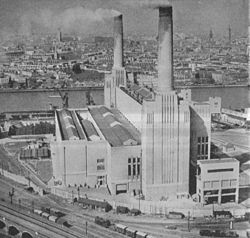1933 in architecture
 From Wikipedia - Reading time: 6 min
From Wikipedia - Reading time: 6 min
| List of years in architecture |
|---|
| (table) |
The year 1933 in architecture involved some significant architectural events and new buildings.
Events
[edit]- The Bauhaus school in Berlin is permanently closed by the Nazi government.
- Modern Architectural Research Group (MARS Group) established as a think tank by younger architects and critics involved in the modernist movement in Great Britain.
- Completion of restoration of Herstmonceux Castle in England by Walter Godfrey.
Buildings and structures
[edit]Buildings opened
[edit]- February 21 – Nebotičnik skyscraper, Ljubljana, Yugoslavia, designed by Vladimir Šubic.
- July – New Midland Hotel, Morecambe, Lancashire, England, designed by Oliver Hill.[1]
- August 23 – Leeds Civic Hall, Yorkshire, England, designed by Vincent Harris in 1926.
- November 29 – Schwandbach Bridge, Switzerland, designed by Robert Maillart.
- Royal Masonic Hospital (later Ravenscourt Park Hospital) at Ravenscourt Park in London, designed by Thomas S. Tait of Sir John Burnet, Tait and Lorne.[2][3]
- Labworth Café on Canvey Island, England, designed by engineer Ove Arup.
Buildings completed
[edit]
- St Gabriel's Anglican Church in Blackburn, England, designed by F. X. Velarde.
- Városmajori Roman Catholic church in Budapest, completed by Bertalan Árkay following the death in 1932 of his father Aladár Árkay.
- Myer Emporium renovation, Bourke Street, Melbourne, Australia.
- The Round House, designed by Berthold Lubetkin's Tecton Architectural Group to house gorillas at London Zoo, one of the first modernist buildings in Britain.[4]
- Battersea Power Station, London, with Giles Gilbert Scott as consultant architect,[5] begins operation.
- College Hall, Royal Air Force College Cranwell, England, designed by James Grey West.
- Mardon Hall, first of the University of Exeter Halls of Residence in England, designed by Vincent Harris.
- Darbishire Quad at Somerville College, Oxford, England, designed by Morley Horder.
- Mercado de Abastos de Algeciras (market hall), Spain, designed by Eduardo Torroja.
- Villa Markelius in Stockholm, designed by Sven Markelius for himself.
- Schminke house in Löbau, Germany, designed by Hans Scharoun.
- Engel House, White City (Tel Aviv), Mandatory Palestine, designed by Zeev Rechter.
- Töss Footbridge, Winterthur, Switzerland, designed by Robert Maillart.[6]
Awards
[edit]- AIA Gold Medal – Ragnar Östberg.
- RIBA Royal Gold Medal – Charles Reed Peers.
- Grand Prix de Rome, architecture – Alexandre Courtois.
Publications
[edit]- John Betjeman – Ghastly Good Taste, or the depressing story of the rise and fall of British architecture.
- The Information Book of Sir John Burnet, Tait & Lorne.
Births
[edit]- February 2 – Rodney Gordon, British architect (died 2008)
- June 25 – Álvaro Siza Vieira, Portuguese architect and architectural educator
- July 23
- Raimund Abraham, Austrian architect (died 2010)[7]
- Richard Rogers, Italian-born British modernist and functionalist architect (died 2021)
- October 29 – John Andrews, Australian architect (died 2022)[8]
- November 4 – Terje Moe, Norwegian architect (died 2009)[9]
- November 24 - Isaac Fola-Alade, Nigerian architect (1004 Estate) (died 2021)
Deaths
[edit]
- January – Edward Lippincott Tilton, American architect based in New York (born 1861)
- March 10 – Émile André, French architect, artist and furniture designer (born 1871)
- April 16 – Harold Peto, English architect and garden designer (born 1854)
- August 8
- Luca Beltrami, Italian architect and architectural historian (born 1854)
- Adolf Loos, Austrian/Czechoslovak architect and writer (born 1870)
- December 4 – W. G. R. Sprague, British theatre architect (born 1863)
- December 24 – Sir Frank Baines, English architect (born 1877)
References
[edit]- ^ Lord Clonmore (1933). "London, Morecambe & elSewhere". Architectural Review. 74: 93–9.
- ^ Gold, Susan. "The Royal Masonic Hospital". The Thirties Society Journal. 2: 29–34.
- ^ Bayer, Patricia (1992). "Civic Structures". Art Deco Architecture: Design, Decoration and Detail from the Twenties and Thirties. London: Thames and Hudson. ISBN 0-500-28149-1.
- ^ "Berthold Lubetkin". Design Museum. Archived from the original on 25 March 2008. Retrieved 2008-03-26.
- ^ Stamp, Gavin. "Battersea Power Station". The Thirties Society Journal. 1: 3–8.
- ^ "Töss Footbridge". Structurae. Retrieved 2015-07-16.
- ^ "Raimund Abraham, Architect With Vision, Dies at 76". nytimes.com. Retrieved 12 March 2017.
- ^ "Vale John Andrews AO". Australian Institute of Architects. 2022-03-28. Retrieved 2023-04-18.
- ^ Henriksen, Petter, ed. (2007). "Terje Moe – arkitekt". Store norske leksikon (in Norwegian). Oslo: Kunnskapsforlaget. Retrieved 2 December 2009.
Licensed under CC BY-SA 3.0 | Source: https://en.wikipedia.org/wiki/1933_in_architecture85 views | Status: cached on August 16 2025 13:44:10↧ Download as ZWI file
 KSF
KSF